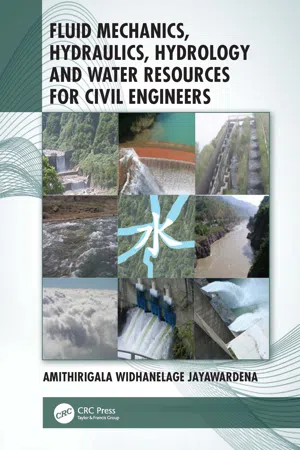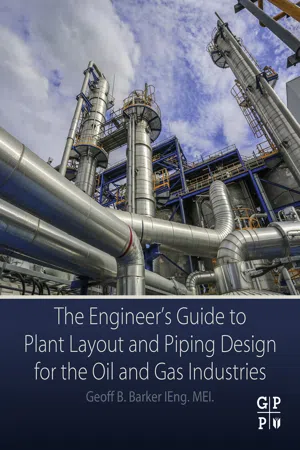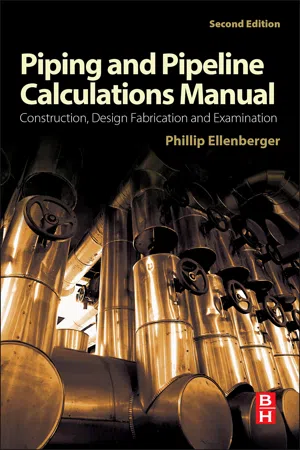Technology & Engineering
Moody Chart
The Moody Chart is a graphical representation used in fluid mechanics to determine the friction factor for flow in a pipe. It combines the Colebrook equation and the Darcy-Weisbach equation to provide a convenient way to calculate pressure drop in pipes. The chart is widely used in engineering for designing and analyzing piping systems.
Written by Perlego with AI-assistance
Related key terms
Related key terms
1 of 4
Related key terms
1 of 3
6 Key excerpts on "Moody Chart"
- eBook - ePub
- Gustavo V. Barbosa-Canovas, Li Ma, Blas J. Barletta(Authors)
- 2017(Publication Date)
- CRC Press(Publisher)
Equation (2.1) by studying head loss (pressure loss) within a pressurized pipeline with various fittings. The system will be under a constant head obtained from a water column of constant height. A series of pressure taps located up and downstream of pipe sections and fittings are connected to manometers, each of which directly indicates the head (expressed in inches of water) at the respective tap location in the system.Friction losses can be predicted if enough information about the system is available. The Moody diagram (Figure 2.2 ) is commonly used for this purpose, out it requires the Reynolds number and information about the roughness factor of the wall of the pipe (normally supplied by the manufacturer). The friction factor (f) is obtained from the diagram, and along with the flow rate, is used to compute the friction losses (Ef ). In this lab the student is expected to compare the experimental data with predicted values. There are also standard formulas and tables (see References [1] and [2] ) to evaluate the losses in fittings that can be compared against experimental data. The fluid used to study friction losses in this lab is water, which is a Newtonian fluid (typical non-Newtonian fluids are tomato sauce or applesauce).2.2 OBJECTIVES (1) To demonstrate the fundamentals of head loss in pipe systems FIGURE 2.1. Schematic illustration of a fluid transport system. FIGURE 2.2. Moody diagram. (2) To measure the friction loss in fittings such as elbows, valves, reductions, and expansions (3) To measure the influence of the flow rate on the friction losses 2.3 MATERIALS AND METHODS 2.3.1 Materials The experimental equipment consists of an arrangement of pipe pieces connected to each other using several types of fittings. The following are the units that should be installed: - Amithirigala Widhanelage Jayawardena(Author)
- 2021(Publication Date)
- CRC Press(Publisher)
Figure 10.6 shows the Moody diagram from Glasgow College of Nautical Studies.Figure 10.6 Moody diagram. (Courtesy of City of Glasgow College, Faculty of Nautical & STEM.)10.8 Typical pipe flow problems
Typical pipe flow problems can be categorized into three types:- Type I: Given Q, L, D, ν, k Find h f
- Type II: Given h f , L, D, ν, k Find Q
- Type III: Given h f , L, Q ,ν, k Find D
10.9 Minor losses in pipes
Losses at entrance, exit, bends, contractions, expansions and pipe fittings, etc. are called minor losses. They are usually expressed as a velocity head in the form((10.40))h L=k LV 22 gwhere k L is the loss coefficient that needs to be experimentally determined, except for sudden expansions. For a sudden expansion from A 1 to A 2 , the loss coefficient is(10.41)k L=(21 −)A 1A 2If A 2 is very large, such as, for example, when a pipe is discharging into a reservoir,, implying that the entire kinetic energy is lost. Loss coefficients can also be expressed in terms of the equivalent pipe length L e ask L= 1(10.42)k L=V 22 g⇒4 fL eV 22 g Dk L=L e; or as4 fDL e=k LD4 fFor short lengths, minor losses may be substantially larger than the frictional losses, and for long lengths, they may be insignificant. For a sudden contraction, it can be shown that (Streeter et al., 1998; p. 300)(h L=- Geoff B. Barker(Author)
- 2017(Publication Date)
- Gulf Professional Publishing(Publisher)
Henry Darcy as Chief Engineer for the department Cote—d'Or in France was promoted to Chief Director for water and pavements in Paris. While in this position, he was able to concentrate on his research into hydraulics. He established a formula for laminar and turbulent flow of liquids in pipes.The diagram below shows how there is a pressure drop between P1 and P2.The Darcy friction factor formulae are equations—based on experimental data and theory—for the Darcy friction factor. The Darcy friction factor is a dimensionless quantity used in the Darcy-Weisbach equation for the description of friction losses in pipe flow as well as open channel flow.It is also known as the Darcy-Weisbach friction factor or Moody friction factor and is four times larger than the Fanning friction factor. The general equation for pressure drop, known as Darcy's formula and expressed in Newtons per square meters of fluid, isΔ P =ρfLv 22 DThe Darcy friction factor for laminar flow (Reynolds number less than 2100) is given by the following formula:(1)f =64 Re==64Dvρµ ′64 µdvρwhere f is the Darcy friction factor and Re is the Reynolds number.•If this quantity is substituted into Eq. (1) , the pressure drop in Newtons per square meter isΔ P = 32 , 000µLvd 2This is Poiseuille ' s law for laminar flowWhen the Re > 4000 (that is the Reynolds number is greater than 4000), the flow is regarded as turbulent.The friction factor depends not only on the Reynolds number but also on the relative roughness.(ɛ /d ), that is, Roughness of pipe walls (ɛ ) compared to diameter of the pipe.The friction factor for smooth pipes (e.g., brass tubing) decreases more rapidly with the increasing Reynolds number than for the pipe with comparatively rough walls.The internal surface of a pipe is independent of the diameter. The friction factor caused by the internal wall roughness has a greater effect on the friction factor in small pipe sizes. This means that a small diameter pipe will approach its rough condition and have a higher friction factor than a larger diameter pipe of the same material.- eBook - ePub
- Roger Legg(Author)
- 2017(Publication Date)
- Butterworth-Heinemann(Publisher)
These variations are shown on the Moody Chart (Fig. 13.7). The friction factor may be calculated from the following equation: Fig. 13.7 Moody Chart—friction coefficient versus Reynolds number. (Based on Fig. 8.1, D.S. Miller, Internal Flow Systems, BHRA Cranfield, with permission.) f = 0.25 log 10 k / 3.7 D + 5.74 / R e D 0.9 2 (13.11) Example 13.5 A 12 m length of 0.3 m diameter galvanized sheet steel duct carries an air flow rate of 0.4 m 3 /s. If the average roughness of the duct is 0.15 mm and the air density is 1.2 kg/m 3 at 20°C, determine the pressure loss due to friction. Solution Duct cross section area: 0.0707 m 2 Mean air velocity: 0.4/0.0707=5.66 m/s The Reynolds number is given by Eq. (13.5) : R e D = v D υ = 5.66 × 0.3 1.5 × 10 − 5 = 1.13 × 10 − 5 The friction factor is given by. Eq. (13.11) : f = 0.25 log 10 k / 3.7 D + 5.74 / R e D 0.9 2 f = 0.25 log 10 0.00015 / 3.70.3 + 5.74 / 113000 0.9 2 f = 0.25 log 10 k / 3.7 D + 5.74 / R e D 0.9 2 = 0.0201 The pressure loss coefficient for the duct is given by Eq. (13.10), i.e., K f = f L D = 0.0201 × 12 0.3 = 0.804 The velocity pressure is given by. Eq. (13.4) : p v = ½ ρ v 2 = 1.2 × 5.66 2 2 = 19.2 Pa Therefore, the pressure loss due to friction, using Eq. (13.9), is: Δ p f = K f p v = 0.804 × 19.2 = 15.5 Pa The result for the friction factor in the above example may be confirmed from the Moody Chart. The relative roughness, k / D, equals 0.00015/0.3 and at a Reynolds number of 1.13×10 3, the friction factor is 0.0201. For manual calculations, it is usual to use a friction chart as described in Chapter 14, leaving the use of Eqs (13.8) and (13.11) for use in computer programs. Pressure Distribution The total energy in a fluid will remain constant unless changed by external forces. Thus, the total pressure will be constant unless frictional or dynamic pressure losses are present - eBook - ePub
- Keith J. Moss(Author)
- 2015(Publication Date)
- Routledge(Publisher)
f = 0.0047. Substituting into the D’Arcy equationSince dP = dh · ρg , pressure lossSUMMARY FOR EXAMPLE 6.5• The specific pressure drop dp = dP /L = 20.8/30 = 0.7 Pa/m. A typical rate of pressure drop in straight ducts for low pressure ventilation and air conditioning systems in which the maximum mean air velocity is around 5 m/s is around 1.0 Pa/m.• Two pressures are present in a system of air flow namely static pressure and velocity pressure. This is discussed more fully in Chapters 5 and 7 .• It is assumed for the purposes of duct sizing that air behaves as an incompressible fluid. This is not necessarily the case at the prime mover or fan where its operating characteristics can show the effects of compression. You should refer to fan manufacturers’ literature here.• It is helpful to consider the maximum mean air velocity attainable in laminar flow in the duct. For laminar flow Re < 2000, thus using equation 6.6 ,from which u = 0.08 m/s. This air velocity is too low for ductwork design; it is therefore invariably in the turbulent region.6.8 Chapter closure
This chapter has provided you with the underpinning knowledge of the two models of fluid flow, namely laminar and turbulent, relating to the flow of water, oil and air in pipes and ducts. It provides a methodology for identifying the type of flow in a system and procedures for solving some problems. The text also defines the pressure losses and mean fluid velocities which one may find in systems conveying oil, air and water. The characteristics of laminar and turbulent flow are discussed in the context of containment in the solid boundaries of the pipe or duct.Further work is investigated in Chapters 5 and 7 . Chapter 7 includes partial flow in pipes and flow in open channels. Part of Appendix 2 - eBook - ePub
Piping and Pipeline Calculations Manual
Construction, Design Fabrication and Examination
- Philip Ellenberger(Author)
- 2014(Publication Date)
- Butterworth-Heinemann(Publisher)
From the example, the formulas give the same answers in both unit systems and either equation form if the appropriate factor is used with the form. Chemists and civil engineers will get the same answer whichever method they choose.This example was for a laminar flow regime; most regimes are not in laminar flow. In the case of turbulent flow the calculation of the factor is not so simple, which was one reason that Moody, for whom the Darcy factor is sometimes named, developed his graph. This was for many years the preferred way to establish the factors. The graph is developed for both the Darcy form and the Fanning form. In the remaining chapters, we will work with the Darcy factors and forms. The graph in the Appendix is presented mainly for reference.The advent of computers and calculators has reduced by a significant amount the work involved in calculating this factor. This is because the calculating equations involve what used to be tedious work, like computing logarithms or making an iterative calculation. Both are done much more simply by today’s electronic wizardry.The base equation is known as the Colebrook equation, which was developed in 1939. It is a generic equation and is based on experiments and other studies, but it can be used for many if not all fluids in the turbulent region. It is not useful for laminar flow, and as discussed, for it to be effective one must first calculate the Reynolds number.One drawback of the equation is that it has the unknown factor f on both sides, so it must be solved iteratively. For those who have an Excel-type spreadsheet with a goal seek tool, this is not as difficult as it used to be. The equation is(4.5)where the symbols have the previous meanings given with the exception of ἒ, which is the roughness factor for the pipe material.For reference, a roughness factor for new steel pipe is 0.00015. As might be expected, this is not a precise factor. It is a reasonable estimate for a particular material. Several materials have different factors and some sources give different estimates. A table of reasonable factors used in this book and by several sources is given in the Appendix.
Index pages curate the most relevant extracts from our library of academic textbooks. They’ve been created using an in-house natural language model (NLM), each adding context and meaning to key research topics.
Explore more topic indexes
Explore more topic indexes
1 of 6
Explore more topic indexes
1 of 4





